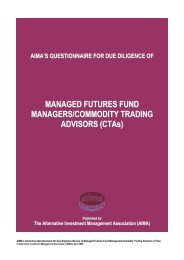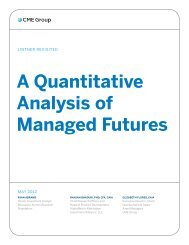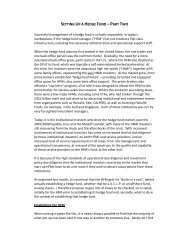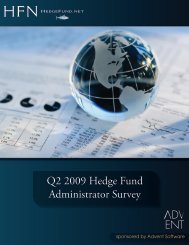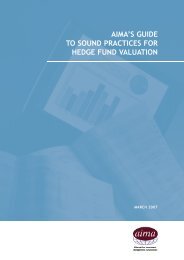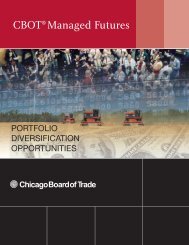Stochastic Volatility and Seasonality in ... - Interconti, Limited
Stochastic Volatility and Seasonality in ... - Interconti, Limited
Stochastic Volatility and Seasonality in ... - Interconti, Limited
You also want an ePaper? Increase the reach of your titles
YUMPU automatically turns print PDFs into web optimized ePapers that Google loves.
a seasonality feature the long-run level for the convenience yield process would thus be 0.0751<br />
(= α 0 /β); we <strong>in</strong>terpret this as the “normal” level of the convenience yield when adjusted for<br />
seasonality.<br />
The seasonal pattern of the mean-revert<strong>in</strong>g level of the convenience yield is also illustrated<br />
<strong>in</strong> Figure 3. The seasonal variation <strong>in</strong> α(t) is very similar to the seasonal variation <strong>in</strong> ν(t),<br />
though amplitudes are different. However, it is much more clear that α(t) has two local maxima<br />
<strong>and</strong> two local m<strong>in</strong>ima. 16 Aga<strong>in</strong>, the global maximum is achieved <strong>in</strong> July about two months<br />
prior to the beg<strong>in</strong>n<strong>in</strong>g of the US harvest<strong>in</strong>g while the global m<strong>in</strong>imum is achieved <strong>and</strong> the end<br />
of the US harvest<strong>in</strong>g. While the US soybean production accounts for 50-60% of world soybean<br />
production other key producers are Argent<strong>in</strong>a <strong>and</strong>, especially, Brazil which are both located<br />
<strong>in</strong> the Southern Hemisphere. These countries account together for 20-30% of world soybean<br />
production. The Brazilian soybean harvest<strong>in</strong>g takes place <strong>in</strong> March <strong>and</strong> April <strong>and</strong> the local<br />
maximum <strong>in</strong> Figure 3 is reached about two months earlier, while the local m<strong>in</strong>imum is reached<br />
dur<strong>in</strong>g the end<strong>in</strong>g of the Brazilian soybean harvest<strong>in</strong>g. The seasonal pattern <strong>in</strong> convenience<br />
yields is thus related to the supply of soybeans. When supplies are low convenience yields are<br />
high, <strong>and</strong> vice versa. This is consistent with the theory of storage which predicts a negative<br />
relationship between <strong>in</strong>ventories <strong>and</strong> convenience yields. The basic idea is that the hold<strong>in</strong>g of<br />
physical <strong>in</strong>ventory of soybeans gives rise to a convenience yield from be<strong>in</strong>g able to profit from<br />
temporary soybean supply shortages or keep a production process runn<strong>in</strong>g especially when<br />
<strong>in</strong>ventories are low. Furthermore, the parameter estimates suggest that the soybean spot price<br />
<strong>and</strong> the convenience yield are positively correlated with a correlation coefficient of 0.3979.<br />
Follow<strong>in</strong>g the above k<strong>in</strong>d of reason<strong>in</strong>g, this is also consistent with the observation that when<br />
supplies <strong>and</strong> <strong>in</strong>ventories are scarce the equilibrium soybean spot price <strong>and</strong> the convenience<br />
yield are simultaneously high; <strong>and</strong> vice versa when supplies <strong>and</strong> <strong>in</strong>ventories are plenty.<br />
On the other h<strong>and</strong>, supporters of the theory of storage often view the convenience yield as<br />
an option to profit from temporary shortages of the particular commodity. This would suggest<br />
a positive correlation between the convenience yield <strong>and</strong> the volatility; however, this view is<br />
not supported by the parameter estimate of ρ 23 which is not significantly different from zero<br />
<strong>and</strong> even estimated negative.<br />
16 The global maximum of the seasonal function α(t) is reached on July 15 where the function value is 0.746,<br />
while the global m<strong>in</strong>imum is reached on October 30 where the function value is -0.723. A local maximum is<br />
reached on February 7, <strong>and</strong> a local m<strong>in</strong>imum is reached on April 16.<br />
20



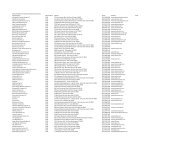
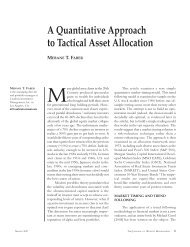

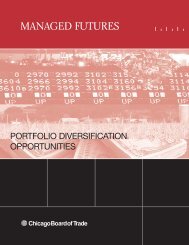
![Definitions & Concepts... [PDF] - Cycles Research Institute](https://img.yumpu.com/26387731/1/190x245/definitions-concepts-pdf-cycles-research-institute.jpg?quality=85)
